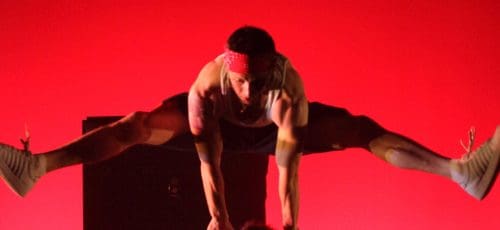Combat Theater and the Flipside of Violence
Terry Brennan puffs up his chest and speaks in a burly voice, mocking his inner idiot superhero. “Screw the system! I’m going to work outside the rules to ensure the rules are in place!”
 As brainchild of Tribe of Fools’ Antihero, the formally-trained gymnast found himself in threatening situations between fantasizing about fighting crime and doing combat-style theater. About five years ago, Brennan heard yelling while walking down South Broad Street in the late evening. Across the street, a guy is grabbing his girlfriend by the hair and “literally throwing her around.” Terry hurried over thinking about how he was probably going to get killed.
As brainchild of Tribe of Fools’ Antihero, the formally-trained gymnast found himself in threatening situations between fantasizing about fighting crime and doing combat-style theater. About five years ago, Brennan heard yelling while walking down South Broad Street in the late evening. Across the street, a guy is grabbing his girlfriend by the hair and “literally throwing her around.” Terry hurried over thinking about how he was probably going to get killed.
“I thought for a day, ‘Maybe I’ll just go around and make sure everyone’s okay.’ Then I thought, ‘That is fucking stupid. That’s what police are for.'”
Brennan did end up diffusing the situation slightly, and that’s when he started posing questions. “You inevitably would misunderstand situations,” he wonders aloud before going into superhero mode again, imagining himself as a bruised waiter ready to save the day after his shift ends.
In a reality without harness wires, the Tribe of Fools cast has been spending the past year learning parkour in a Fishtown studio to get the satire up to cinematic standards (Antihero’s homepage and fundraising site features clips of the cast practicing the street-based sport that involves ad-hoc acrobatics in urban environments). But like dreaming about being a superhero, parkour is not “terribly practical,” to put it in Brennan’s words. It was having to deal with Philadelphia’s public spectacles of domestic abuse and his own ego that left Brennan with unanswered questions about the physical residues of violence and a pitch for Tribe of Fools.
“It rests on the idea that the single individual sees everything incredibly clearly and doesn’t make any mistakes . . . we always cast ourselves as the hero.”
The poignancy and purpose for Antihero for Brennan comes in getting over the theatrics of violence in order exposing our personal responsibilities for violence. “I’ve never met anyone who’s said, ‘You know what the problem is? It’s me.’ That’s where this comes out of.” Brennan recalled how a day before our interview, he witnessed a man dragging a woman on the floor in a South Philly alleyway near Brennan’s block.
 When he started punching her full force in the face, “I just couldn’t take it anymore.” Brennan rushed behind the man and held his arms back long enough so that the young woman could escape. Brennan ran back to his living room to a furious girlfriend and some strange sensations.
When he started punching her full force in the face, “I just couldn’t take it anymore.” Brennan rushed behind the man and held his arms back long enough so that the young woman could escape. Brennan ran back to his living room to a furious girlfriend and some strange sensations.
“Even though [defending people] brings up a lot of weird feelings, there is a rush. There’s a lot of endorphins that run through your body.” Brennan wants to evoke what we get cheated out of at the movie theater.”When an act of violence of occurs, there’s all these unpredictable elements that just live in the air and float around.” He gets pissed off at how we have to be vigilant about challenging illusions of violence and heroism, such as his cousin’s idea that the last Ironman flick is going to prepare us to defend ourselves.
“I think the biggest disservice is that [movies] act like the when the actual act is done, that everything’s gone . . . they tell me that as long as I have good intentions, I can win a fight, and that is not true.”
By no means is Antihero a serious play. As the clips of parkour attest to, kicking and punching people is usually dealt with as a joke, and Brennan makes it clear that he’s not here to make a sociological analysis anytime soon. “We have a vocabulary in our culture of violence being hilarious, and we want to play on that.”
Antihero comes across as a joke on big cinema and a metaphor for the reality of theater and violence. Without the luxury of flying equipment and multiple retakes, we get an entertaining hybrid of the two that is sure to be thought-provoking.
-Monica Rocha


